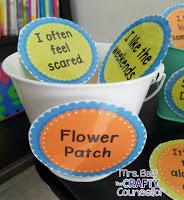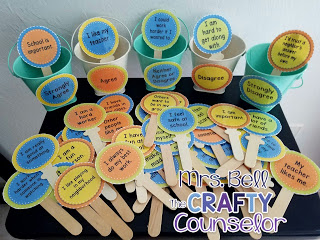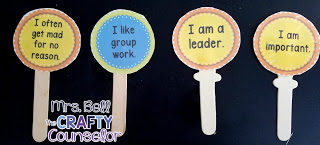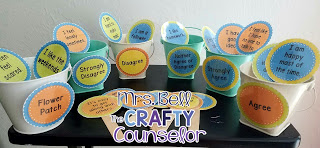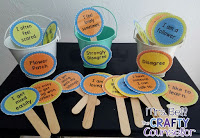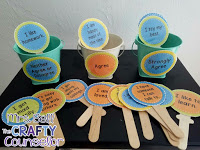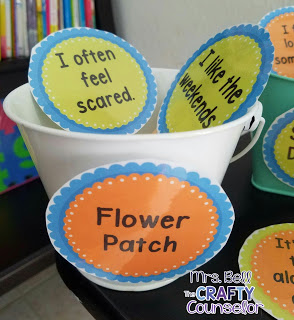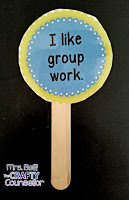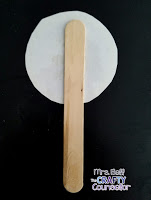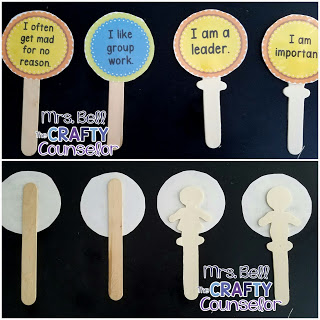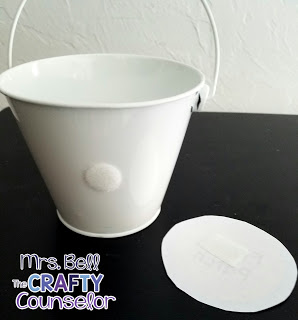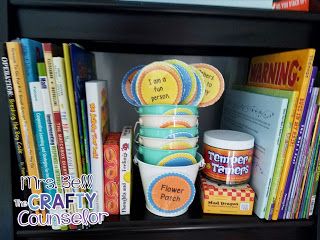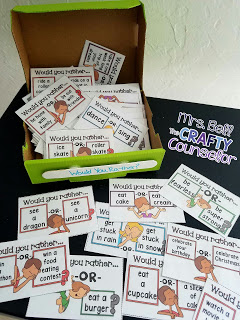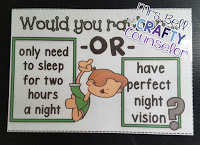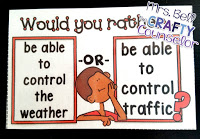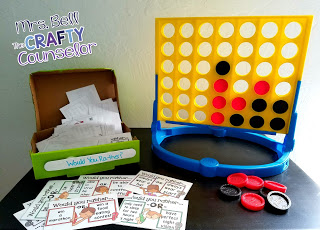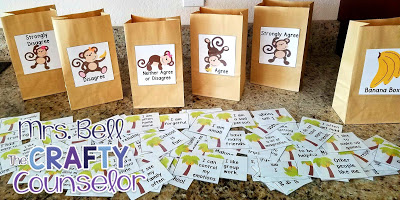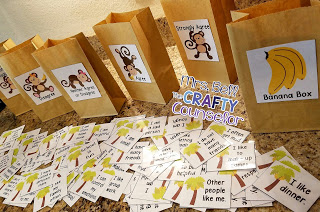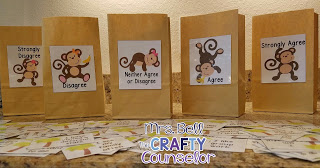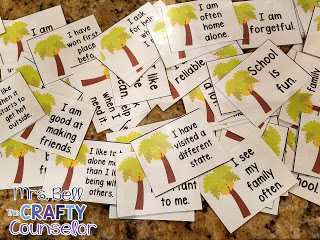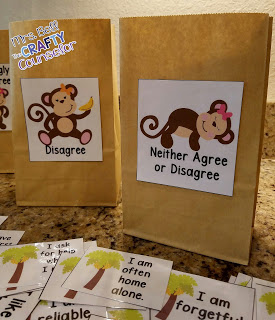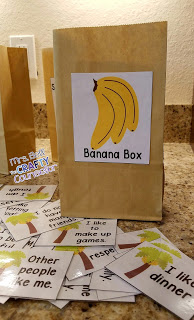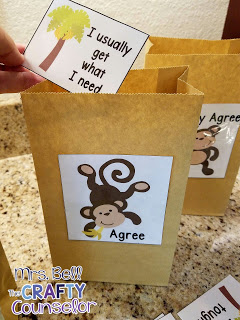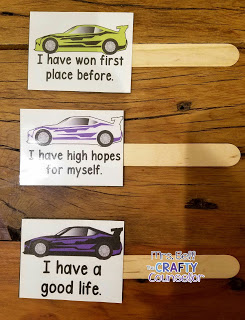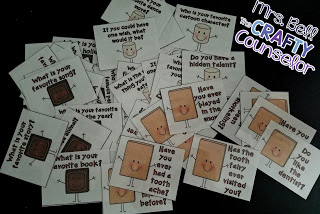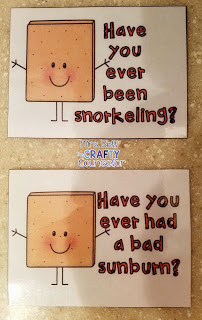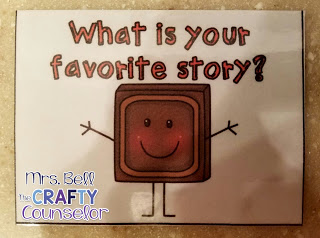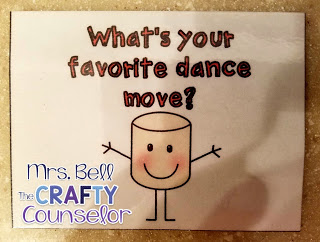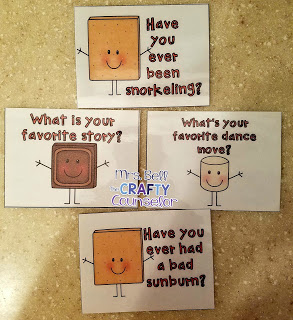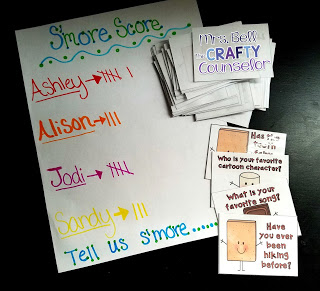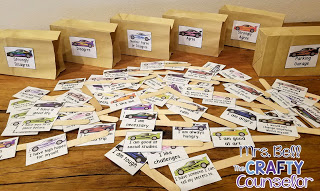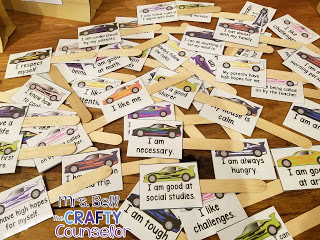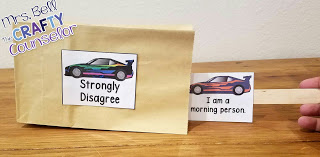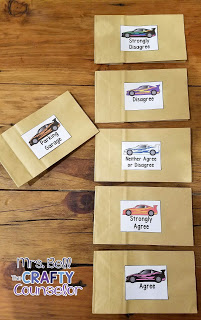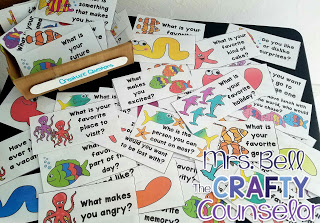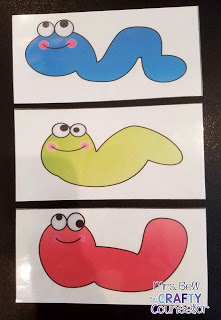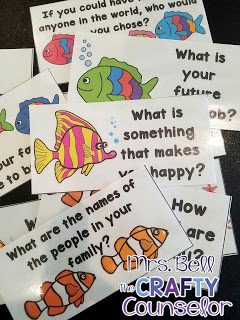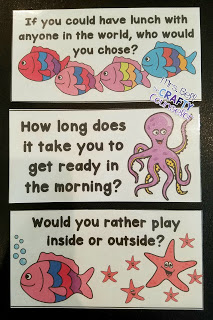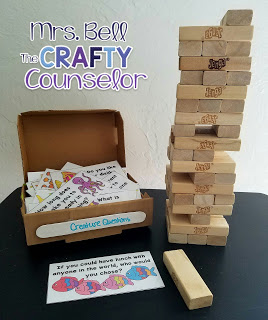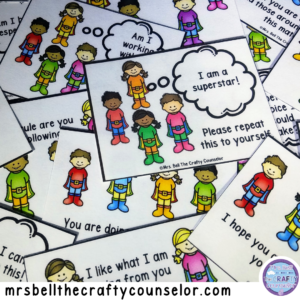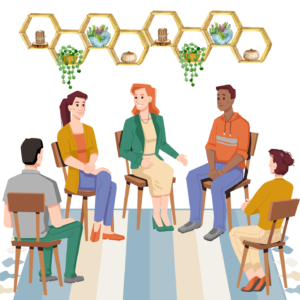
Six Creative Ways to Get Kids Talking
It can be challenging to get
students to open up to you. It takes time and patience. For us School
Counselors, patience is plentiful, time however, is not. Here are six creative games
I came up with that are sure to get kids to open up much quicker than a
standard conversation. Kids don’t want to sit and talk about potentially deep
issues they don’t know how to explain. They do however love to play a game while
enjoying the one on one attention that come with talking to the School
Counselor.
students to open up to you. It takes time and patience. For us School
Counselors, patience is plentiful, time however, is not. Here are six creative games
I came up with that are sure to get kids to open up much quicker than a
standard conversation. Kids don’t want to sit and talk about potentially deep
issues they don’t know how to explain. They do however love to play a game while
enjoying the one on one attention that come with talking to the School
Counselor.
You can download your own copy of this six resource bundle here.
Some kids open up slowly, you have to help them work up to
it. Sometimes the well-intended questions we ask, push a kid further away from
us. Due to this, I like giving kids a way to momentarily avoid talking about something
difficult. I like to give them time to think about how they want to approach
the subject without feeling the pressure. If they are allowed time to warm up
to the idea of sharing something with me slowly, I feel like they are more
likely to eventually open up and share instead of shutting me out and avoiding
the subject all together.
it. Sometimes the well-intended questions we ask, push a kid further away from
us. Due to this, I like giving kids a way to momentarily avoid talking about something
difficult. I like to give them time to think about how they want to approach
the subject without feeling the pressure. If they are allowed time to warm up
to the idea of sharing something with me slowly, I feel like they are more
likely to eventually open up and share instead of shutting me out and avoiding
the subject all together.
Although I love to give students the right to some privacy,
having a reserved student who isn’t saying much can make it really hard for
school counselors to figure out what the heck is going on.
having a reserved student who isn’t saying much can make it really hard for
school counselors to figure out what the heck is going on.
This is why I love this “Rank These Statements” game and the
concept of a flower patch.
concept of a flower patch.
Flower
statements is a game comprised of statements that students rate on a scale of
five from strongly disagree to strongly agree. Students pick up a statement,
such as, I like school.
statements is a game comprised of statements that students rate on a scale of
five from strongly disagree to strongly agree. Students pick up a statement,
such as, I like school.
Then they rank the statement based on how much it applies to
them.
them.
There is a sixth option called the flower patch. If a
student doesn’t want to rank the statement just then, they can send it to the
flower patch. This area is
reserved for statement flowers the student isn’t quite ready to deal with. We
send those statement flowers back to the flower patch so they can have time to
grow a bit more. If we’re lucky, sometime soon the flower patch flowers will be
ready to be ranked.
student doesn’t want to rank the statement just then, they can send it to the
flower patch. This area is
reserved for statement flowers the student isn’t quite ready to deal with. We
send those statement flowers back to the flower patch so they can have time to
grow a bit more. If we’re lucky, sometime soon the flower patch flowers will be
ready to be ranked.
The flower patch allows a student to put a subject aside, to
deal with it later if they choose. What they put in the flower patch is very
telling. It gives me as the School Counselor a hint as to what is really going
on in this kid’s world.
deal with it later if they choose. What they put in the flower patch is very
telling. It gives me as the School Counselor a hint as to what is really going
on in this kid’s world.
There are 204 statements
included, making it easy to customize the game to the child by allowing you to
sort and pick statements that apply to your situation. I usually pick 20-30
statement flowers max.
included, making it easy to customize the game to the child by allowing you to
sort and pick statements that apply to your situation. I usually pick 20-30
statement flowers max.
They are relatively easy to
make. After I printed, laminated and cut apart all of the flowers, I then got to hot gluing the flowers to the Popsicle sticks. It made for
a fun Saturday afternoon.
make. After I printed, laminated and cut apart all of the flowers, I then got to hot gluing the flowers to the Popsicle sticks. It made for
a fun Saturday afternoon.
I had two different kinds of
Popsicle sticks. One were plain and one had little mini people. The kids
thought that the mini people were hilarious and were blown away that from the
front the feet looked like leaves.
Popsicle sticks. One were plain and one had little mini people. The kids
thought that the mini people were hilarious and were blown away that from the
front the feet looked like leaves.
What a happy resourceful
little accident.
little accident.
I
created little flower buckets for the various ranking areas using mini flower
pots, Velcro and the included labels that came with the download.
created little flower buckets for the various ranking areas using mini flower
pots, Velcro and the included labels that came with the download.
It is a really easy way to
get kids talking!
get kids talking!
I love this game for students that need a laugh,
students that need to calm down a bit, students I want to know better or with
my small groups as an icebreaker activity.
students that need to calm down a bit, students I want to know better or with
my small groups as an icebreaker activity.
It is hilarious how seriously they contemplate their
two decisions; laughing at the absurd decisions they have to make and
contemplating the real life consequences of fulfilling their choices.
two decisions; laughing at the absurd decisions they have to make and
contemplating the real life consequences of fulfilling their choices.
If I’m playing one on one with a student, I
like to couple it with some kind of board game. For the most part, students
don’t sit down and play games with their parents anymore, they miss out on the
skills that are developed when they play a game in real life with adults.
like to couple it with some kind of board game. For the most part, students
don’t sit down and play games with their parents anymore, they miss out on the
skills that are developed when they play a game in real life with adults.
I think playing games helps us bond.
My go-to add on games are Connect 4 or Jenga. With
this game, after you pick a Would You Rather card and answer the question, you can
than take your turn in Connect 4. It definitely gets and keeps the conversation going!
this game, after you pick a Would You Rather card and answer the question, you can
than take your turn in Connect 4. It definitely gets and keeps the conversation going!
This game is much like the flower statements
game. The premise is that students “feed” the banana statements to the correct
monkey ranking strongly disagree to strongly agree depending on how the student
feels.
game. The premise is that students “feed” the banana statements to the correct
monkey ranking strongly disagree to strongly agree depending on how the student
feels.
There is also a banana box that holds banana
statements that aren’t quite ripe enough to be talked about yet. Students put
the banana statements in this box that need a bit more time before they are
ready to be talked about.
statements that aren’t quite ripe enough to be talked about yet. Students put
the banana statements in this box that need a bit more time before they are
ready to be talked about.
I used paper bags to
create six different ranking areas. I printed and laminated the ranking labels
and then hot glued them to the bags. You could use just about anything you want
to create the ranking spots.
create six different ranking areas. I printed and laminated the ranking labels
and then hot glued them to the bags. You could use just about anything you want
to create the ranking spots.
Here are the rules
for this “Rank These Statements” Game:
1. Chose from the 198 Banana Statements to find
the specific statements you want to utilize with the student. Choices depend on
the reasoning behind your time together and time restrictions.
for this “Rank These Statements” Game:
1. Chose from the 198 Banana Statements to find
the specific statements you want to utilize with the student. Choices depend on
the reasoning behind your time together and time restrictions.
2. Explain the system of ranking to the
student. Make sure they understand the words agree and disagree and understand
the differences between the six ranking areas. Show students how they can
“feed” the monkeys the Banana Statements by putting statements in the
appropriate bags/containers. Talk through a few choices together to make sure
the student fully understands the ranking systems.
student. Make sure they understand the words agree and disagree and understand
the differences between the six ranking areas. Show students how they can
“feed” the monkeys the Banana Statements by putting statements in the
appropriate bags/containers. Talk through a few choices together to make sure
the student fully understands the ranking systems.
3. Explain the concept
of the “Banana Box” to the student. This area is reserved for Banana Statements
the student isn’t quite ready to deal with. These bananas need a little longer to
ripen, they aren’t quite ready to be ranked and fed to the monkeys. We put
those Banana Statements in the Banana Box for safe keeping. If we’re lucky,
sometime soon the Banana Box statements will be ready to be picked up and
ranked. Be prepared to explain words written on the Banana Statements to
students if necessary.
of the “Banana Box” to the student. This area is reserved for Banana Statements
the student isn’t quite ready to deal with. These bananas need a little longer to
ripen, they aren’t quite ready to be ranked and fed to the monkeys. We put
those Banana Statements in the Banana Box for safe keeping. If we’re lucky,
sometime soon the Banana Box statements will be ready to be picked up and
ranked. Be prepared to explain words written on the Banana Statements to
students if necessary.
4. Once the student fully understands, have
them pick a Banana Statement, one at a time, and read the statement out loud.
Have them think about how much they agree or disagree with the statement. Have
them drop their statement into the appropriate monkey boxes that matches their
level of agreement.
them pick a Banana Statement, one at a time, and read the statement out loud.
Have them think about how much they agree or disagree with the statement. Have
them drop their statement into the appropriate monkey boxes that matches their
level of agreement.
In the end you will know a whole lot more about
what the child thinks and feels. When appropriate, revisit anything that
surprised or worried you.
what the child thinks and feels. When appropriate, revisit anything that
surprised or worried you.
This game is too stinkin’ cute. It’s just like
a regular pick a card, answer the question game, only there is a competitive
edge added to this game. The whole point is to pick the correct amount of each
card to earn points!
a regular pick a card, answer the question game, only there is a competitive
edge added to this game. The whole point is to pick the correct amount of each
card to earn points!
To earn a point, you need to pick and answer:
Two graham cracker cards,
one chocolate card,
and one marshmallow card.
You need all four cards in order to build a
full s’more and earn a point!
full s’more and earn a point!
If they pick a “Tell Me S’more Free Pass” they
get a bonus point!
get a bonus point!
In the end, the person with the highest S’more
Score (the most points) wins!
Score (the most points) wins!
Watch out, students get competitive during this
game! They try to cheat and look at the upside down cards from just the right
angel to find their needed symbol to stack up more s’more points.
game! They try to cheat and look at the upside down cards from just the right
angel to find their needed symbol to stack up more s’more points.
Just a suggestion, keep the cards inside
something the kids can’t see through!
something the kids can’t see through!
Much
like flowers and banana statements, the car statement games require students to
rank various statements. The idea is that students “park the cars” into the
labeled “garages” depending on how much they agree or disagree with the
statement.
like flowers and banana statements, the car statement games require students to
rank various statements. The idea is that students “park the cars” into the
labeled “garages” depending on how much they agree or disagree with the
statement.
Just
like the other games, there are five ranking stations, or garages, and a
parking lot of cars that aren’t quite ready to be sent to a garage yet. They hang
out in the parking lot until the student is ready to decide which garage they
should park in.
like the other games, there are five ranking stations, or garages, and a
parking lot of cars that aren’t quite ready to be sent to a garage yet. They hang
out in the parking lot until the student is ready to decide which garage they
should park in.
They
are really easy to make.
are really easy to make.
Print,
laminate and cut apart the car statements and then hot glue to Popsicle sticks
to create a handle for students.
laminate and cut apart the car statements and then hot glue to Popsicle sticks
to create a handle for students.
I
liked to glue the stick sideways so that it could look like the car was
actually driving.
liked to glue the stick sideways so that it could look like the car was
actually driving.
It
is super easy and the kids think it is super cute! They love to make engine revving
sounds as they drive their cars to their ranking spots.
is super easy and the kids think it is super cute! They love to make engine revving
sounds as they drive their cars to their ranking spots.
The
ranking spots are just brown paper bags with the labels included in the
download hot glued to the front of the bags.
ranking spots are just brown paper bags with the labels included in the
download hot glued to the front of the bags.
Place all the cards upside down in a pile or
spread them out face down across a table. One at a time, students “fish” for a
card. Once they land their “creature”, they read the question written on their
catch out loud and provide an answer.
spread them out face down across a table. One at a time, students “fish” for a
card. Once they land their “creature”, they read the question written on their
catch out loud and provide an answer.
If they choose a Take
the Bait Card (worm on the card with no written question), they get to tell the
group a fun fact about themselves or make up a question to answer.
the Bait Card (worm on the card with no written question), they get to tell the
group a fun fact about themselves or make up a question to answer.
For a twist, after
picking a card, have students ask the person to their right to answer the
question. If they choose a Take the Bait Card with no written question, they
get to make up and ask a question of their choice.
picking a card, have students ask the person to their right to answer the
question. If they choose a Take the Bait Card with no written question, they
get to make up and ask a question of their choice.
When I am playing with a single student, I like
to couple the game with Jenga. Asking a ton of questions one on one, especially
with a student you don’t know very well, can make some students uncomfortable.
I find having a game of Jenga going on takes some of the pressure off. It makes
it seem like you’re just chatting over a friendly game.
to couple the game with Jenga. Asking a ton of questions one on one, especially
with a student you don’t know very well, can make some students uncomfortable.
I find having a game of Jenga going on takes some of the pressure off. It makes
it seem like you’re just chatting over a friendly game.
It really gets students to open up.
There
you have it, six creative ways to get students talking. You can download your
own copy of the six resource bundle here.
you have it, six creative ways to get students talking. You can download your
own copy of the six resource bundle here.
What
do you do to get students to open up? How do you conquer the super shy and
inhibited students? Ever had a student talk so much you wish they were a bit shyer?
I’d love to hear about your experiences, let’s connect!! I look forward to
hearing from! J
do you do to get students to open up? How do you conquer the super shy and
inhibited students? Ever had a student talk so much you wish they were a bit shyer?
I’d love to hear about your experiences, let’s connect!! I look forward to
hearing from! J
Let’s connect:
Follow Me on TeachersPayTeachers
Follow Me on TeachersPayTeachers
Read more...
Share it...
You might also like...

Hi, I'm Ashley!
I am a school counselor who helps educators to change the lives of students with engaging, creative, and meaningful SEL resources.

